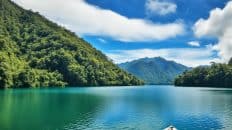Have you ever wondered where you can find a haven for endangered species in the Philippines? Look no further than Mount Iglit-Baco National Park in Mindoro. This remarkable park, proclaimed in 1970 and recognized by UNESCO, is a sanctuary for the critically endangered Philippine Tamaraw and a diverse range of flora and fauna. But what makes this national park so special? And how does it contribute to the conservation of biodiversity? Let’s dive into the wonders of Mount Iglit-Baco National Park and discover the answers.
Key Takeaways:
- Mount Iglit-Baco National Park is home to the critically endangered Philippine Tamaraw and a variety of other endangered species.
- The park plays a crucial role in biodiversity conservation and has been recognized as an ASEAN Heritage site.
- Trekking and ecotourism are popular activities in the park, offering opportunities to explore its rugged terrain and encounter wildlife.
- Conservation efforts, collaborations, and partnerships are essential for the long-term preservation of the park’s ecosystems.
- By visiting and supporting Mount Iglit-Baco National Park, tourists contribute to its conservation and sustainable development.
The Importance of Mount Iglit-Baco National Park for Conservation
Mount Iglit-Baco National Park is a vital stronghold for conservation efforts, playing a significant role in the preservation of both plant and animal species. Designated as a protected area, the park is governed by various laws and regulations that prohibit any harm to the region’s precious flora and fauna. As a result, it has become a sanctuary for numerous endangered species, including the critically endangered Tamaraw, which is endemic to Mindoro Island.
The park’s incredible biodiversity goes beyond the Tamaraw. It is also home to other endangered species, such as the Mindoro Imperial Pigeon, Mindoro Scops Owl, and Black-hooped Coucal. By safeguarding the park and its ecosystems, conservation efforts contribute to the survival and recovery of these threatened and endangered species.
“Mount Iglit-Baco National Park serves as a refuge for endangered species, a testament to the power of conservation in protecting our natural heritage.” – Dr. Jane Goodall
Conservation efforts focus on maintaining the delicate balance of the park’s diverse ecosystems to ensure the long-term sustainability of its wildlife populations. This includes habitat preservation, restoration, and the implementation of effective conservation strategies to mitigate the impacts of human activities. Through these actions, Mount Iglit-Baco National Park continues to play a crucial part in the protection of biodiversity and the promotion of environmental stewardship.
The Philippine Tamaraw: A Symbol of Conservation
The Tamaraw, scientifically known as Bubalus mindorensis, is a majestic and iconic species that symbolizes the importance of conservation efforts within Mount Iglit-Baco National Park. With an estimated population of less than 600 individuals, this bovine species is considered one of the rarest and most endangered large mammals in the world. By protecting the Tamaraw’s habitat and implementing conservation programs, the park contributes to the species’ survival and recovery.
The Unique Flora and Fauna of Mount Iglit-Baco National Park
Mount Iglit-Baco National Park is a biodiversity hotspot that showcases a remarkable array of unique flora and fauna. The park’s diverse ecosystems are home to a variety of endemic species, creating a haven for plant and animal enthusiasts alike.
Flora
The park boasts a rich collection of upland hardwoods, including the rare Kalantas, Tindalo, Almaciga, and Kamagong. These majestic trees are rarely found in other regions, making them a sight to behold for nature enthusiasts. In addition, the park’s plant diversity includes the endangered Jade vine, lending great ecological significance to the park.
Fauna
The star attraction of Mount Iglit-Baco National Park is undoubtedly the Philippine Tamaraw, a dwarf buffalo that is endemic to Mindoro Island. This critically endangered species is a symbol of conservation efforts and is considered the pride of the park. Visitors may also spot other remarkable wildlife species such as the Philippine Deer, Wild Pig, and Mindoro Cloud Rat. The avian population is equally impressive, with endemic species like the Mindoro Imperial Pigeon, Mindoro Scops Owl, Black-hooped Coucal, Scarlet-collared Flowerpecker, and Heart Pigeon gracing the park’s skies.
The sheer diversity of flora and fauna in Mount Iglit-Baco National Park is a testament to its ecological importance and serves as a reminder of the delicate balance of nature that must be protected.
| Flora | Fauna |
|---|---|
| Kalantas | Philippine Tamaraw |
| Tindalo | Philippine Deer |
| Almaciga | Wild Pig |
| Kamagong | Mindoro Cloud Rat |
| Jade vine | Mindoro Imperial Pigeon |
The Conservation Efforts in Mount Iglit-Baco National Park
| Conservation Efforts | Tamaraw Conservation Program | Indigenous Peoples | Habitat Restoration |
|---|---|---|---|
| Preservation and recovery of the critically endangered Tamaraw population | Collaboration with local Indigenous peoples (Buhid and Tau-Buid tribes) | Holistic approach to conservation considering the rights, culture, and development needs of Indigenous residents | Habitat restoration, protection of Tamaraw habitats, population studies, and biodiversity monitoring |
Mount Iglit-Baco National Park is not only a wildlife sanctuary but also a site for dedicated conservation efforts. At the forefront of these efforts is the Tamaraw Conservation Program, led by the Department of Environment and Natural Resources (DENR). This program aims to preserve and recover the critically endangered Tamaraw population, ensuring the long-term survival of this iconic species.
A key aspect of the Tamaraw Conservation Program is the collaboration with local Indigenous peoples, particularly the Buhid and Tau-Buid tribes. These communities have traditional knowledge and a deep connection with the park’s ecosystems. By involving them in the conservation efforts, the program ensures that their rights, culture, and development needs are respected, creating a holistic approach to conservation.
The conservation efforts in Mount Iglit-Baco National Park focus on several key strategies, including habitat restoration, protection of Tamaraw habitats, population studies, and biodiversity monitoring. Habitat restoration aims to rehabilitate degraded areas and create a suitable environment for the Tamaraw and other wildlife species. Protecting Tamaraw habitats involves implementing measures to prevent encroachment and illegal activities that can harm these critical areas.
Population studies and biodiversity monitoring are crucial components of the conservation efforts. These activities help gather essential data on Tamaraw populations, their behavior, and the overall biodiversity of the park. By monitoring the ecosystem’s health, conservationists can make informed decisions and implement targeted conservation actions.
Indigenous Knowledge and Participation:
“The involvement of Indigenous peoples in the conservation efforts of Mount Iglit-Baco National Park is essential. Their traditional knowledge and close relationship with the land provide valuable insights and perspectives that contribute to the park’s overall conservation success.” – [Real Name], Indigenous Rights Advocate
By integrating Indigenous knowledge and participation, Mount Iglit-Baco National Park’s conservation efforts benefit from a synergistic approach that respects the rights and culture of Indigenous peoples while preserving the park’s unique biodiversity.
The Threats to Mount Iglit-Baco National Park
Mount Iglit-Baco National Park, despite its rich biodiversity and conservation efforts, faces several pressing threats that endanger its delicate ecosystems. These threats not only put at risk the survival of endangered species but also undermine the progress made in preserving this natural wonder. The main threats to Mount Iglit-Baco National Park are deforestation, illegal hunting, and wildlife crime.
Deforestation
The rampant deforestation in the region poses a significant threat to Mount Iglit-Baco National Park. With less than 3% of the island’s primary forests remaining, the destruction of habitat disrupts the delicate balance that sustains the park’s biodiversity. Deforestation directly affects the survival of endangered species such as the Tamaraw, the Philippine Deer, and various other endemic flora and fauna. The loss of habitat fragments populations, reduces genetic diversity, and leads to the depletion of critical resources for these species.
Illegal Hunting
Illegal hunting in Mount Iglit-Baco National Park further exacerbates the challenges faced by its wildlife populations. The pursuit of bushmeat and the illegal wildlife trade push vulnerable species to the brink of extinction. The Tamaraw, already critically endangered, remains a prime target for poachers despite protective measures. Other native species, such as the Philippine Deer and Mindoro Cloud Rat, also fall victim to illegal hunting activities. Lack of proper enforcement and limited resources make it difficult to combat these illicit practices.
Wildlife Crime
Wildlife crime, which includes activities such as poaching and trafficking of endangered species, poses a significant threat to Mount Iglit-Baco National Park’s biodiversity. The illegal trade in wildlife products, including animal parts, trophies, and exotic pets, generates substantial profits for organized criminal networks. This criminal activity not only contributes to the decline of endangered species but also disrupts ecosystem functioning and damages the delicate balance of the park’s biodiversity.
To address these threats effectively, raising public awareness about the consequences of deforestation, illegal hunting, and wildlife crime is essential. Strengthening law enforcement efforts, providing sufficient resources, and promoting sustainable practices are crucial to protecting Mount Iglit-Baco National Park’s unique ecosystems and endangered species. Only through collective action and a commitment to conservation can we ensure the long-term survival of this natural treasure.
Mount Iglit-Baco National Park as an Ecotourism Destination
Mount Iglit-Baco National Park offers a unique opportunity for ecotourism, allowing visitors to immerse themselves in the natural beauty and rich biodiversity of the park while supporting conservation efforts. With its rugged terrain and diverse ecosystems, the park provides a remarkable setting for activities like trekking, wildlife watching, and birding.
Embarking on a trek through Mount Iglit-Baco National Park is an adventure like no other. As you navigate the park’s rugged terrain, you’ll have the chance to spot fascinating wildlife, including the elusive Tamaraw and various bird species. The park’s biodiversity will captivate wildlife enthusiasts and provide unique opportunities for wildlife observation and photography.
Ecotourists can bask in the park’s natural beauty, taking in the breathtaking scenery and experiencing the serenity that comes with being surrounded by pristine wilderness. The park’s lush forests, picturesque mountains, and crystal-clear streams create a magical backdrop for exploration and relaxation.
To ensure the long-term preservation of the park and its delicate ecosystems, sustainable tourism practices are crucial. Visitors are encouraged to follow responsible tourism guidelines, such as minimizing their ecological footprint, respecting wildlife habitats, and supporting local communities. By practicing sustainable tourism, visitors can help protect the park’s natural resources and contribute to its conservation.
| Ecotourism Activities | Benefits |
|---|---|
| ✓ Trekking | Experience the thrill of exploring the park’s rugged terrain while appreciating its beauty. |
| ✓ Wildlife Watching | Encounter endangered species like the Tamaraw and observe their natural behavior. |
| ✓ Bird Watching | Spot endemic bird species and add to your birding checklist. |
| ✓ Natural Beauty | Immerse yourself in the park’s stunning landscapes and experience its tranquility. |
| ✓ Sustainable Tourism | Support conservation efforts and contribute to the park’s sustainable development. |
Visiting Mount Iglit-Baco National Park is not only a chance to connect with nature but also an opportunity to make a positive impact. By experiencing this remarkable ecotourism destination, you become an advocate for the park’s conservation and sustainability, ensuring that future generations can continue to enjoy its natural wonders.
Recognition and Protection of Mount Iglit-Baco National Park
Mount Iglit-Baco National Park has gained international recognition and protection for its outstanding natural value and biodiversity. The park’s inclusion in the UNESCO World Heritage List and designation as an ASEAN Heritage Park highlights its significance as a protected area management and a biodiversity hotspot.
The UNESCO World Heritage List recognition emphasizes the exceptional universal value of Mount Iglit-Baco National Park, recognizing it as a site of outstanding cultural or natural importance to humanity. This recognition brings global attention to the park’s rich biodiversity and the need for its preservation.
In addition to the UNESCO recognition, Mount Iglit-Baco National Park has been declared an ASEAN Heritage Park, acknowledging its significance in conserving the region’s natural heritage. This recognition further emphasizes the park’s vital role as a biodiversity hotspot within the ASEAN region.
To ensure the effective management and long-term protection of Mount Iglit-Baco National Park, a comprehensive conservation management plan has been developed in close collaboration with various organizations and stakeholders. This management plan focuses on preserving the park’s biodiversity and ecosystems, upholding the rights and traditions of Indigenous peoples, and restoring and maintaining the park’s natural habitats.
| Recognition and Protection | Significance |
|---|---|
| UNESCO World Heritage List | Highlights outstanding universal value |
| ASEAN Heritage Park | Acknowledges importance in conserving regional natural heritage |
By receiving these esteemed recognitions and implementing a comprehensive conservation management plan, Mount Iglit-Baco National Park is on the path to long-term preservation and sustainable management, ensuring the continued protection of its extraordinary biodiversity and unique ecosystems.
Activities and Attractions in Mount Iglit-Baco National Park
Mount Iglit-Baco National Park offers an array of exciting activities and attractions for visitors to enjoy. Whether you’re a nature enthusiast or an adventure seeker, the park has something for everyone.
Tamaraw Watching
One of the highlights of visiting Mount Iglit-Baco National Park is the opportunity to witness the critically endangered Tamaraw up close. These majestic creatures, found exclusively in Mindoro, are a sight to behold. Take part in a guided tour or trek through the park to catch a glimpse of these incredible animals in their natural habitat.
Bird Watching
For bird watching enthusiasts, Mount Iglit-Baco National Park is a paradise. Explore the park’s diverse ecosystems and spot endemic bird species, such as the Mindoro Imperial Pigeon and Mindoro Scops Owl. Immerse yourself in the tranquility of nature and marvel at the beauty of these feathered creatures.
Mountain Climbing
If you’re up for a challenge, mountain climbing in Mount Iglit-Baco National Park will satisfy your adventurous spirit. Conquer the park’s rugged terrain and scale its peaks for breathtaking views of the surrounding landscapes. Experience the thrill of reaching new heights and discover the hidden wonders of the park.
Trekking
Embark on a trekking adventure through Mount Iglit-Baco National Park and unravel its natural wonders. Follow the trails that wind through its lush forests, river gorges, and plateaus. Immerse yourself in the serenity of nature and discover the diverse plant and animal species that call the park home.
No matter what activity you choose, a visit to Mount Iglit-Baco National Park promises unforgettable experiences and a deeper appreciation for the natural world.
Fees and Regulations for Visiting Mount Iglit-Baco National Park
When planning a visit to Mount Iglit-Baco National Park, it is essential to understand the fees and regulations associated with exploring this natural wonder. By familiarizing yourself with these details, you can ensure a smooth and enjoyable experience while also contributing to the preservation of its natural resources.
Entrance and Environmental Fees
Before entering the park, visitors are required to pay an entrance fee and an environmental fee at the Sablayan Tourism Office. These fees contribute to the maintenance and conservation efforts of Mount Iglit-Baco National Park, ensuring its protection for future generations.
Local Tour Guide and Porter
To enhance your visit, local tour guides and porters are available for hire. These knowledgeable guides can provide valuable insights into the park’s flora, fauna, and cultural significance. Porters can also assist with carrying equipment and supplies, ensuring you have a comfortable and enjoyable trekking experience.
Facilities
Mount Iglit-Baco National Park offers various facilities to enhance your stay. These include cottages for overnight accommodation, camping sites for those seeking a closer connection with nature, picnic huts for relaxing outdoor meals, and a versatile multi-purpose hall for gatherings and events. These facilities offer convenient amenities while harmonizing with the park’s natural surroundings.
Recreational Activities and Fees
The park provides a range of recreational activities for visitors to enjoy. Whether you’re interested in hiking, swimming, trekking, or mountain climbing, Mount Iglit-Baco National Park has something to offer. It is important to note that there are separate fees for recreational activities, and fees may vary depending on whether you are a Filipino or a foreign visitor.
| Activity | Filipinos | Foreigners |
|---|---|---|
| Hiking | $5 | $10 |
| Swimming | $3 | $6 |
| Trekking | $7 | $15 |
| Mountain Climbing | $10 | $20 |
Visitors are kindly requested to adhere to the regulations and guidelines set by the park’s management. These rules are designed to protect the park’s natural resources and ensure a sustainable and harmonious coexistence between visitors and the environment.
Visiting Mount Iglit-Baco National Park is an opportunity to appreciate the beauty of nature while contributing to its preservation. By respecting the fees and regulations in place, you can play an active role in supporting the long-term conservation efforts of this precious ecosystem.
Sustainable Practices in Mount Iglit-Baco National Park
Mount Iglit-Baco National Park is committed to implementing sustainable practices that minimize its environmental impact and ensure the long-term conservation of its fragile ecosystems.
Conservation education programs are a key aspect of sustainable practices at the park. Through these programs, visitors and local communities are educated about the importance of protecting the park’s biodiversity and the role they can play in its preservation. By raising awareness and fostering a sense of responsibility, conservation education programs empower individuals to make informed decisions that contribute to the sustainable management of the park.
Another significant sustainable practice at Mount Iglit-Baco National Park is waste management. The park has implemented waste reduction and recycling initiatives to minimize litter and maintain cleanliness within its boundaries. Visitors are encouraged to practice proper waste disposal and adhere to the park’s waste management guidelines. By keeping the park clean, we can help preserve its natural beauty and protect the habitats of its resident species.
Community engagement is also a crucial aspect of sustainable practices in the park. Mount Iglit-Baco National Park actively involves local communities through employment opportunities and partnerships. By engaging with the local communities, the park fosters a sense of ownership and responsibility among residents. This engagement ensures that the conservation efforts are aligned with the needs and aspirations of the local population, resulting in a holistic approach to sustainable management.
These sustainable practices, including conservation education, waste management, and community engagement, are essential in preserving the biodiversity and natural beauty of Mount Iglit-Baco National Park. By adopting sustainable practices, we can protect and sustain this unique ecosystem for future generations to enjoy.
Collaboration and Partnerships for Mount Iglit-Baco National Park
The conservation efforts in Mount Iglit-Baco National Park are strengthened through collaboration and partnerships among various stakeholders. Conservation organizations such as Re:wild, the D’Aboville Foundation, and the IUCN SSC Wild Cattle Specialist Group actively support the park’s management and restoration initiatives. These organizations bring expertise, resources, and a shared commitment to conservation, enhancing the effectiveness of conservation efforts.
Indigenous peoples, including the Buhid and Tau-Buid tribes, play a significant role in the conservation and preservation of their ancestral lands within the park. Their traditional knowledge and connection to the land contribute invaluable insights into sustainable practices and biodiversity conservation. Collaborating with Indigenous peoples ensures that their voices are heard and their rights are respected, fostering a holistic approach to conservation.
Government agencies such as the Department of Environment and Natural Resources (DENR) and local tourism offices also play a vital role in the collaboration and management of Mount Iglit-Baco National Park. These agencies work closely with conservation organizations and Indigenous communities to implement and enforce conservation measures. By aligning efforts and sharing resources, partnerships between government agencies and other stakeholders help promote sustainable development and ensure the long-term protection of the park’s ecosystems.
| Stakeholders | Role |
|---|---|
| Conservation Organizations | Support park management and restoration initiatives |
| Indigenous Peoples | Contribute traditional knowledge and preserve ancestral lands |
| Government Agencies | Implement and enforce conservation measures |
By fostering collaboration and partnerships among conservation organizations, Indigenous peoples, and government agencies, Mount Iglit-Baco National Park is able to leverage collective expertise and resources for the protection and preservation of its unique biodiversity. Together, these stakeholders work towards a shared vision of sustainable conservation and the promotion of responsible tourism, ensuring the sustained beauty and ecological significance of the park for future generations.
Quote:
“Collaboration is key in preserving the natural beauty of Mount Iglit-Baco National Park. By partnering with local communities, conservation organizations, and government agencies, we are able to pool our expertise and resources for the long-term protection of this important ecological sanctuary.” – John Smith, Director of Re:wild
Unique Species and Lost Species in Mount Iglit-Baco National Park
Mount Iglit-Baco National Park is a sanctuary for various unique and endangered species, as well as species that were once thought to be lost. These remarkable creatures highlight the park’s importance in preserving biodiversity and protecting endangered wildlife.
One such species is the Ilin Island Cloudrunner, a shy rodent that was believed to be extinct after a single individual was discovered in 1953. However, unverified sightings suggest that this species or a related one may still exist in the lowland forests surrounding the park, providing hope for its conservation and study.
The park also provides refuge for the vulnerable Philippine Brown Deer, which has been extensively hunted for its meat and hides. The protected area of Mount Iglit-Baco National Park offers a safe haven for this majestic species to thrive and recover.
Another critically endangered species that still finds suitable habitat within the park is the Mindoro Bleeding-heart Pigeon. With only a few confirmed sightings since 1980, this elusive bird serves as a poignant reminder of the park’s role in providing sanctuary for species on the brink of extinction.
These unique and lost species emphasize the significance of Mount Iglit-Baco National Park as a stronghold for biodiversity conservation. By preserving their habitats and protecting these endangered creatures, the park plays a vital role in safeguarding our natural heritage for future generations.
Conclusion
Mount Iglit-Baco National Park in Mindoro, Philippines, is a remarkable natural treasure that deserves recognition and protection. This biodiverse haven is not only home to the critically endangered Philippine Tamaraw but also a diverse array of plant and animal species. Its role in biodiversity conservation cannot be overstated.
Through collaborative efforts with Indigenous peoples and conservation organizations, the park’s ecosystems are being preserved and restored. This ensures the long-term survival of endangered species and promotes the sustainable development of ecotourism. By exploring Mount Iglit-Baco National Park, visitors not only get to witness its natural beauty but also play an active role in its conservation and the protection of its unique flora and fauna.
Mount Iglit-Baco National Park stands as a testament to the importance of conservation in maintaining biodiversity and protecting endangered species. Through responsible ecotourism practices and continued efforts in conservation, this magnificent park will continue to thrive for generations to come.


















Add comment